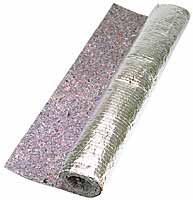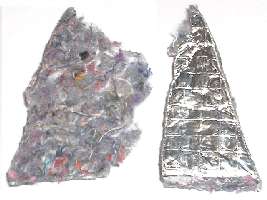The MGA With An Attitude
|
| MGAguru.com |
|
MGAguru.com |
HUSHMAT Is Not Thermal Insulation -- INT-201A
At 12:21 AM 7/16/2019, Lin Sharpe( via Groups.Io) wrote:
 "I'm applying HushMat to my interior to help with heat and noise. My plan is to apply it to the larger panel sections but leave plenty of room near the fasteners. I'm not planning to mummify the interior with mastic sheets, but mostly get the heat of of the transmission tunnel off my ankle. "I'm applying HushMat to my interior to help with heat and noise. My plan is to apply it to the larger panel sections but leave plenty of room near the fasteners. I'm not planning to mummify the interior with mastic sheets, but mostly get the heat of of the transmission tunnel off my ankle.
 My carpet kit came with an insulation pad, too. Could/should that be used in conjunction with the HushMat? Barney's notes mentioned tight clearance when adding pad near the hand brake and side rails. Are there other areas to watch out for clearances or just avoid? Just looking for any guidance so I'm not coming back in 6 months from now with a heat gun and scraper". My carpet kit came with an insulation pad, too. Could/should that be used in conjunction with the HushMat? Barney's notes mentioned tight clearance when adding pad near the hand brake and side rails. Are there other areas to watch out for clearances or just avoid? Just looking for any guidance so I'm not coming back in 6 months from now with a heat gun and scraper".
This bugs me more every time the discussion comes up, so I figure this is a good time to offer some comments. Begin with these quotes from the HushMat web page:
 "Reduce noise & vibration > 50%. Reduce heat > 40% with one material. .... Ultra is light weight at 0.47 pounds per square foot and is slightly less than 1/8th inch thick (1.5mm)". "Reduce noise & vibration > 50%. Reduce heat > 40% with one material. .... Ultra is light weight at 0.47 pounds per square foot and is slightly less than 1/8th inch thick (1.5mm)".
Sheet metal in the MGA body is 18-gauge (0.048" thick), 2-lb per square foot. HushMat is then 1/4 the weight of sheet metal, so that looks like light weight material (relatively speaking), but if you do the whole interior it could easily be 15 to 20 pounds. However, the material is quite thin, as 1.5-mm is actually only 1/16-inch (only 25% thicker than the sheet metal). That makes (average) density of the material 0.2x of steel, or 0.06 lb/cu-in. But it is not solid one-type material, it is a thin layer of aluminum over some softer and lighter material. It gets its sound damping quality from the metal surface stopping sound waves while the underlying soft material is absorbing the energy of the sound waves.
I will concede without argument that their claims may actually be true. With the most optimistic point of view, I suppose these numbers come from comparison with a single layer of bare sheet metal. 50% reduction of noise and vibration would be about equal to having two layers of sheet metal, not physically connected. That is, two thin layers of metal, not one double thickness layer. So a layer of HushMat over steel will cut noise by half. So far so good (sort of), but maybe not a good as it first sounds.
For heat, reduction of 40% would mean that a layer of HushMat (0.06" thick) has thermal resistance about 2/3 that of a layer of steel (0.048" thick). I would have thought it could be better. Would you lay your leg against a tunnel composed of two layers of sheet metal? I don't think so. In reality, HushMat is a good sound deadener, but does very little as a thermal insulator (as may soon become clearer).
Without a perfect vacuum, one of the best thermal insulators is air. If you want effective thermal insulation you want to trap air under your carpet. The easy way to do this is to install a thick layer of felt or horse-hair or shredded rag or low density foam rubber, or some combination of these something like for instance:
J.C. Whitney's "Space Age Insulation":


Or Moss Motors "Foil Heatshield Insulation", 48" x 72", $39.99 ($1.67 per sq-ft):
https://mossmotors.com/foil-heatshield-48-x-72
There is a function of diminishing returns where 3/8" is good, 1/2" a little better. But you could spend twice as much to double the thickness with only a small additional improvement, and that may cause space problems with fitting of seats and hand brake lever. Plywood is also a better insulator than steel, and is a lot thicker, so the plywood floor 3/8" thick is pretty good thermal insulation. In the floor, 3/8" plywood + 3/8" felt + 1/4" carpet makes a 1" stack of insulation, which is pretty good. On the tunnel 3/8" felt +1/4" carpet is not bad, still feels warm on your leg, but not hot. If you want better thermal insulation there, consider something more on the under side of the tunnel (for interior space consideration).
Now having gotten that far, lets go back to consideration of additional HushMat which you would put against the tunnel or on the floor under the carpet padding. Since HushMat for thermal insulation is barely better than an additional layer of sheet metal, would you bother with the thermal advantage of another layer of sheet metal under the normal carpet padding? Hardly worth the added expense. For heat insulation stick with cheap carpet padding and forget the expensive HushMat.
HushMat can be a decent sound deadener, but again there is a function of diminishing returns. Carpet padding and carpet are also pretty good sound deadeners. A race car may run with no fabric on the interior surfaces, but not your street car. Once you have carpet padding and carpet inside, an additional layer of HushMat under there is again similar to an additional layer of sheet metal. It would help some, but in most cases not worth the additional cost and time to install it.
My MGA on the road at speed makes a lot more noise around the top (open or closed) than what comes through the bottom. For a reference experiment, take a cruise at expressway speed, then depress the clutch and take your foot off the throttle to let it idle while coasting fast. Then consider the difference in noise level, and you may discover that most of the noise is up top and not so much underneath. This means that additional insulation in the floor and tunnel is even more subject to diminishing returns, not doing anything at all for the majority of noise up above.
Once you get past the urge for additional sound deadening in the floor, I can make a couple more recommendations for adding insulation. I highly recommend installation of the under dash pad for both sound and heat insulation between you and the engine bay because the single layer of sheet metal there transmits a large dose of both.
I also like to insulate and/or carpet the battery cover, not so much for heat, but to substantially lower road noise and exhaust noise coming from the back. If you haven't done it yet, just throw a blanket over the battery cover and go for a spin (maybe on a rough road surface). You could also temporarily remove the battery cover to see how much noise there is wanting to come through there. Retaining the stowed convertible top and the side screen stowage bag also reduces noise from the rear.
Carpeting the boot floor also reduces noise from the rear. It may help a little with road noise and exhaust noise, but can definitely help a lot if you have any loose objects that are free to bounce around in the boot. I drove my MGA once with a tool box and no carpet in the boot, after I had been used to the boot being carpeted. What a racket that made every time it hit a bump, and it was also beating paint off of the boot floor in short order. You don't have to carpet the whole boot interior, just throw in a loose piece of carpet the right size to cover the boot floor all the way to the corners.
Enough for now, just food for thought.
|
|